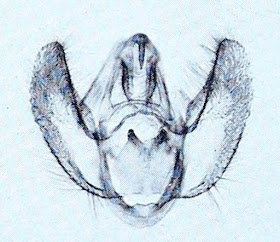Comocritis Meyrick, 1894
Comocritis Meyrick, 1894 (Hyponomeutidae). On a collection of Lepidoptera from Upper Burma. Trans ent. Soc. London 1894: 1–29 [24]. Type species: Comocritis olympia Meyrick, 1894 by monotypy.
Comocritis Meyrick 1894. Meyrick, 1920, A Sketch of our Present Knowledge of Indian Microlepidoptera. Fletcher, T.B. (ed.) Report of the Proceedings of the Third Entomological Meeting held at Pusa on the 3rd to 15th February 1919. Calcutta : Superintendent Government Printing. (999-1009) [1006].
Comocritis Meyrick, 1894 [Yponomeutidae]. Fletcher, T. B., 1929, A list of generic names used for Microlepidoptera. Memoirs of the Department of Agriculture of India, 11: 1-244 [53]. (999-1009) [1006].
Comocritis Meyrick, 1894. Clarke, J. F. Gates, 1955, Catalogue of the type specimens of Microlepidoptera in the British Museum (Natural History) described by Edward Meyrick. London : British Museum (Natural History). v5, 1-581 [306-11].
Comocritis Meyrick, 1894. Nielsen, Edwards, & Rangsi, 1996, Checklist of the Lepidoptera of Australia. Monographs on Australian Lepidoptera, 4: i-xiv, 1-529; & CD-ROM [86].
Comocritis Meyrick, 1894 (Yponomeutidae, Yponomeutinae). Beccaloni, G. W., Scoble, M. J., Robinson, G. S. & Pitkin, B. (Editors). 2003. The Global Lepidoptera Names Index (LepIndex). World Wide Web electronic publication. http://www.nhm.ac.uk/entomology/lepindex [accessed 5 April 2010].
Comocritis Meyrick, 1894 (Yponomeutidae, Yponomeutinae). Beccaloni, G. W., Scoble, M. J., Robinson, G. S. & Pitkin, B. (Editors). 2003. The Global Lepidoptera Names Index (LepIndex). World Wide Web electronic publication. http://www.nhm.ac.uk/entomology/lepindex [accessed 5 April 2010].
Comocritis Meyrick, 1894. Edwards, E. D. (2003), Xyloryctinae. Australian Faunal Directory. Australian Biological Resources Study, Canberra. http://www.environment.gov.au/biodiversity/abrs/online-resources/fauna/afd/taxa/XYLORYCTINAE [accessed 16 June 2010].
Comocritis Meyrick 1894(Yponomeutidae, Yponomeutinae). B. Pitkin and P. Jenkins, Butterflies and Moths of the World: Generic Names and their Type-species, 2004. World Wide Web electronic publication. http://www.nhm.ac.uk/research-curation/research/projects/butmoth/ [accessed 16 June 2010].
Original desription, Meyrick 1894
Comocritis, n.g.
Head with appressed scales, sidetufts loosely spreading, projecting- between antennae; ocelli. present;- tongue developed. Antennae 2/3, in ♂ shortly bipectinated, with .streak of rough scales on back near base, basal joint large, with dense pecten. Labial palpi moderate, curved, ascending, second joint loosely-scaled, terminal joint less than half second, pointed. Maxillary palpi very short, filiform. Posterior tibiae clothed with rough scales. Forewings with vein 1 b furcate, 2 from near angle, 7 to costa, 11 from middle, with a subhyaline groove on lower surface beneath 12 towards base. Hindwings 1, elongate-ovate, .cilia ¼, veins 3 and 4 from a point, 5 and 6 somewhat approximated at base.
Allied to Oeta [= Atteva, Yponomeutidae], but not closely.
Description:
Thorax:
Wings, Comocritis olympia, Gates Clark 1955.
WIng venation, Comocritis olympia, Gates Clark 1955.
Immature stages:
Distribution: Queensland, Papua New Guinea. (Edwards, 2003).
Remarks: The late J. Kyrki of Finland had informed us that Comocritis should not be in the Yponomeutoidea but he did not know its correct family. (Pitkin and Jenkins, 2004).
_____________________________________
Comocritis sp. A
Comocritis sp. A., ANIC. Daintree forest, south of Cooktown.
Comocritis sp. A., IM18-0001, Imbil, Queensland. 5 January 2018.
Ian McMillan photos.
Comocritis sp. A. Nielsen, E.S., Edwards, E.D. & Rangsi, T.V. 1996. Checklist of the Lepidoptera of Australia. Monogr. Aust. Lepid. 4: i–xiv, 1–529 & CD–ROM [86].
Diagnosis:
Description:
Head:
Thorax:
Abdomen:
Comocritis sp. A, IM18-0001, abdominal pelt. Dissection courtesy of Canadian National Collection of Insects, Arachnids, and Nematodes, Agriculture and Agri-Food Canada.
Comocritis sp. A, IM18-0001,male genitalia. Dissection courtesy of Canadian National Collection of Insects, Arachnids, and Nematodes, Agriculture and Agri-Food Canada.
Food plants: larvae of Indian species feed on lichens and the bark of trees. (Meyrick 1920).
Flight period:
Distribution: Queensland, from the Daintree, south of Cooktown (Edwards, pers. comm., 2009).
Imbil, South-east Queensland.
Imbil, South-east Queensland.
Remarks: Very close to C. olympia. The serrations on the phallus relate to similar structures in C. heliconia and C. thespias (Gates Clark, 1955).
There appears to be a well-formed transtilla in the dissected male genitalia. This feature is otherwise absent in the Xyloryctidae. The relative size of the genitalia and phallus is also most untypical of other Australian Xyloryctidae. Barcoding results have proved to be inconclusive, as there is not enough material for comparison; whether this genus belongs in the Xyloryctidae remains a mystery. Apparently not related to other Australian genera; may be introduced.
There appears to be a well-formed transtilla in the dissected male genitalia. This feature is otherwise absent in the Xyloryctidae. The relative size of the genitalia and phallus is also most untypical of other Australian Xyloryctidae. Barcoding results have proved to be inconclusive, as there is not enough material for comparison; whether this genus belongs in the Xyloryctidae remains a mystery. Apparently not related to other Australian genera; may be introduced.
Page updated 15 September 2019.
_____________________________________










